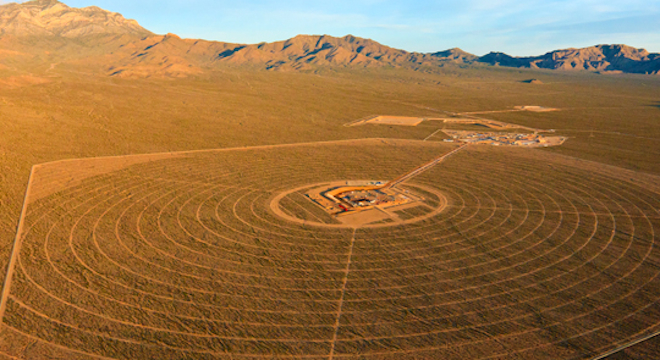Updated 7:53 pm ET Monday, November 28
Google’s renewable energy initiative, Renewable Energy Cheaper Than Coal, was one of the seven products and services that got the axe last week, along with Google Wave and Knol.
At the time, Google defended the decision in a blog post, writing “other institutions are better positioned than Google to take this research to the next level.”
And as the company also noted, it is in the midst of a multi-stage “spring cleaning” effort designed to streamline the company’s products and services, which began shortly after Google co-founder Larry Page took over as CEO and former CEO Eric Schmidt stepped aside to become chairman in January.
In June, Google announced it was discontinuing another green energy project, PowerMeter, a web-based tool that allowed customers to monitor their home energy usage. The project was formally ended on September 16.
But a recent series of reports suggests that Google’s renewable energy program was the victim of its own outsized, if unfocused, ambitions.
As the New York Times reported on Monday, Google’s renewable energy program produced numerous ideas on how to improve the technology behind the still-under-construction Ivanpah Solar Electric Generating System in the Mojave Desert, California.
That’s a $2.2 billion project that its creators call the “world’s largest solar thermal facility,” a.k.a. a “solar power tower” that generates electricity by having a field of mirrors, called heliostats, reflect concentrated sunlight back at the tower, which contains liquid that turns to steam or vapor when heated, turning a generator.
However, none of Google’s ideas will actually be used to improve the project, The Times points out.
That didn’t stop Google from posting the fruits of its heliostat research on Google.org, the search giant’s philanthropic arm.
Among those ideas floated include using a “Brayton engine,” a.k.a. a custom-built jet engine, instead of a conventional steam generator. Google admits that “we did not ultimately carry out our design through to a prototype,” and notes that one aspect of its design, a solar receiver, “proved to be much more difficult than originally expected…A viable design may be possible with ceramic materials, but much more development is required.”
It’s unclear what effect Google’s withdrawal will have on the Ivanpah Solar project. The Times notes that the $168 million Google promised to invest in the project is going forward.
At the time of this post, the project’s website still prominently included Google among those partner companies listed. According to the latest official update, made before Google’s abrupt announcement, the project is still on schedule
More ominously for Google’s future support for renewable energy is the fact that the company’s so-called “Green Energy Czar,” Bill Weihl, announced in early November that he was leaving the company after five years. His announcement also came before Google said it would be pulling the plug on the program.
Weihl told Fresh Dialogues that the reason he was leaving was because it was “time to move on and find something new.”
He also added that he still stood by an earlier statement in September that the “Solyndra debacle will not impact smart venture capital investment” in renewable energy projects.
However, as Fresh Dialogues also noted, Google seems to be in no hurry to replace Weihl, with a Google spokesman telling the outlet that “Bill (Weihl) played a unique and important role bridging several different internal teams. But we have a strong team in place. Urs Hoelzle will continue to lead our data center efficiency and renewable power purchase efforts, and Rick Needham leads on sustainability and renewable energy investments.”
Weihl previously raised some doubts about Google’s ability to advance the renewable energy sector, telling Mother Jones in 2008 that: “We think that focused investment with some small teams of very smart people has the chance to really make some breakthroughs there. But then we are also going to need investment in manufacturing and building and installing these systems at enormous scale and growing that industry at a really incredible rate. And it’s not clear to me what the right way is to make that happen yet.”
Indeed, in Google’s own remarks following the closure of Renewable Energy Cheaper than Coal indicate that at the very least, the company will be scaling back its green efforts.
Under a final, brief paragraph entitled “Additional renewable energy activities,” Google promised it would “continue to pursue a wide range of other activities in support of renewable energy — from our on-campus efforts and energy for our data centers, to our more than $850 million in investments to further develop and deploy renewable energy technologies. We’re excited about contributing to the path toward a more sustainable energy future.”
Essentially, Google is saying that it is dialing-back its alternative energy support to projects closer to home, at its various office buildings and 900,000 plus server farms. That’s hardly a very specific or ambitious roadmap, at least compared to the company’s prior efforts.
And still unknown are just what impact Google’s revamped, streamlined company strategy will have on other unrelated green energy projects, including Google Green, a larger umbrella of efforts to reduce energy usage within and outside of Google, Google’s clean energy power purchase agreements and Google’s overall philanthropic arm, Google.org, which recently provided funding for a nationwide map of continental U.S. geothermal resources.
We’ve reached out to Google and its partners on the Ivanpah solar project, including thermal solar power systems company BrightSource, power company NRG Energy and construction company Bechtel, and will update when we receive a response.
First update: Kristin Hunter, a spokeswoman for BrightSource, emailed TPM with the following statement explaining that Google’s support for Ivanpah remains steadfast:
“Per Google’s blog post, Google is still an investor in Ivanpah and will continue to make investments in clean energy projects. Google’s research will not be used at Ivanpah because BrightSource, a leading solar thermal technology company, is the technology provider, not Google.”
Second update: Google’s Clean Energy spokesman Parag Chokshi contacted TPM with additional information surrounding the closure of the Renewable Energy Cheaper than Coal initiative and Google’s commitment to clean energy going forward.
Firstly, Chokshi clarified that “nobody’s been laid off” as a result of the sunset of the Renewable Energy Cheaper than Coal Initiative, including Google green czar Bill Weihl, who Chokshi said left of his own volition. TPM has reached out to Weihl for more information on his departure.
Chokshi explained that although Weihl’s contribution to the company’s green energy efforts were vast and unparalleled, it isn’t necessary for Google to find an immediate replacement for his position to keep its current projects — data center greening and investment in renewables among the two foremost — going.
“We’ve got a really solid team to continue the great work Bill started,” Chokshi told TPM in a phone call.
Chokshi also said that the closure of the initiative and posting of Google’s research findings on Ivanpah’s solar power tower technology aren’t indicative of any wavering support for either that project or the technology behind it.
“We still think power tower technology is compelling,” Chokshi said, “We wouldn’t have invested as much as we did unless we really believed in the technology. We remain committed to investing in the sector.”
Chokshi said the company had stopped its own efforts to improve the technology because other companies, including BrightSource, were better positioned to do so, as it is their singular focus, compared to Google, which has a myriad set of renewable energy interests.
One of those interests, according to Chokshi, is looking to invest in geothermal. Google hasn’t actually invested in a specific geothermal provider yet, but after financing the completion of the latest U.S. Geothermal Map, showing the country has 10-times as much geothermal resource as coal, the company is now actively seeking geothermal companies to add to its investment portfolio.
Finally, Chokshi pointed to the fact that Google is continuing to advance its own green energy technology efforts. The company’s latest data center, the Hamina Data Center which opened earlier this year in Finland, was built out of a converted 60-year-old paper mill. It relies on a custom-built seawater cooling system that takes advantage of the nearby Gulf of Finland.
“We don’t ever want to be just maintaining our green energy efforts,” said Chokshi. “We always want to be doing new and interesting things.”
Chokshi noted that of the $850 million Google has invested in renewable energy, some $700 million was invested this year alone, and that there would be more to come next year.
Correction: This article originally misidentified the location of the Hamina Data Center as “near Zurich, Switzerland” as noted by several readers. The story has since been corrected. We regret the error.









